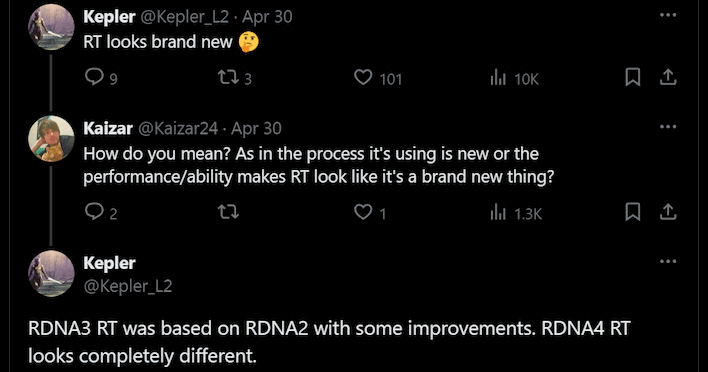AMD's RDNA 2 and RDNA 3 GPUs, even the ones as small as the integrated GPU on the Steam Deck, fully support DirectX Ray-Tracing, or DXR. Despite that, their relatively poor performance in ray-tracing workloads is well-documented. The reason is because the RDNA 2 and RDNA 3 architectures only accelerate a small (but critical) portion of the ray-tracing workload. The GPUs themselves aren't really designed around it the way NVIDIA's Ampere and especially Ada Lovelace GPUs are. Even Arc Alchemist
has better ray-tracing capability.
This was a design decision that AMD made years ago when the RDNA 2 architecture was in its infancy. However, ray-traced effects are starting to become more common in more games, and we're also starting to see the emergence of more path-traced titles beyond just
Minecraft RTX and
Quake II RTX. Games like
Alan Wake II and
Dragon's Dogma 2 both have path-traced lighting functions, and it's likely that this method will become more commonplace as time goes on.
AMD
clearly understands this, and we knew that RDNA 4 would bring considerable improvements to the ray-tracing performance of Radeon graphics processors, but we didn't know to what degree AMD was focusing on this area. It turns out that it might have been the company's primary focus for the new GPUs. We say that because frequent AMD leaker Kepler (known as @Kepler_L2 on Xwitter) has just revealed that the RDNA 4 ray-tracing functionality does not appear to be based on the RDNA 3 design, but rather a completely new configuration.
This can only really be good news for AMD. Its current- and even previous-generation Radeon cards offer excellent raster performance and give a great gaming experience for not a lot of money—as long as your game makes very sparse use (or no use) of ray-tracing. As soon as you flip on those toggles for improved reflections, shadows, and indirect lighting, game performance tanks on something like
a Radeon RX 6800 XT. A game that is specifically programmed with the RDNA limitations in mind, like
Metro Exodus Enhanced Edition, can still run very well and look fantastic, but games with less-optimized ray-tracing implementations will really struggle.
It's a little bit unfortunate that the weak ray-tracing performance of AMD's current-generation cards seems to have somewhat poisoned them in the minds of PC gaming enthusiasts. The thing is, very few people who are spending money on discrete GPUs want anything less than the maximum visual quality; having to turn down settings to get a good experience in your game feels really bad to DIY builders and other enthusiasts. Here's hoping that
AMD's next-generation RDNA 4 graphics cards won't suffer such an indignity.



